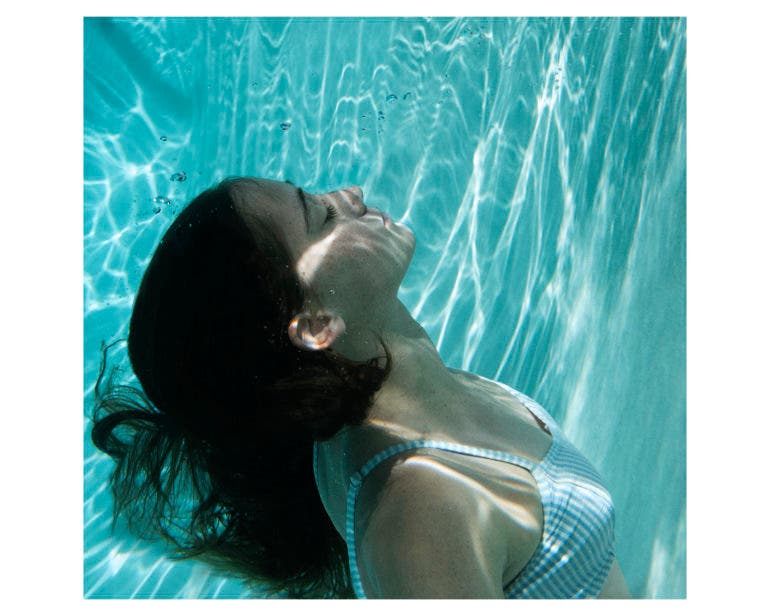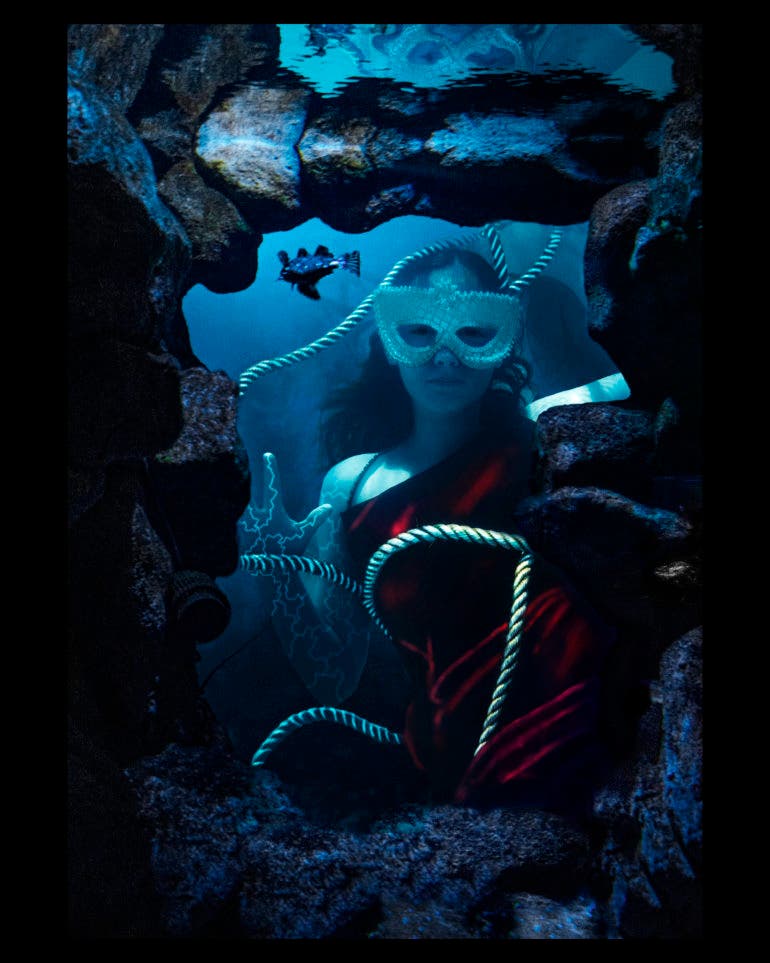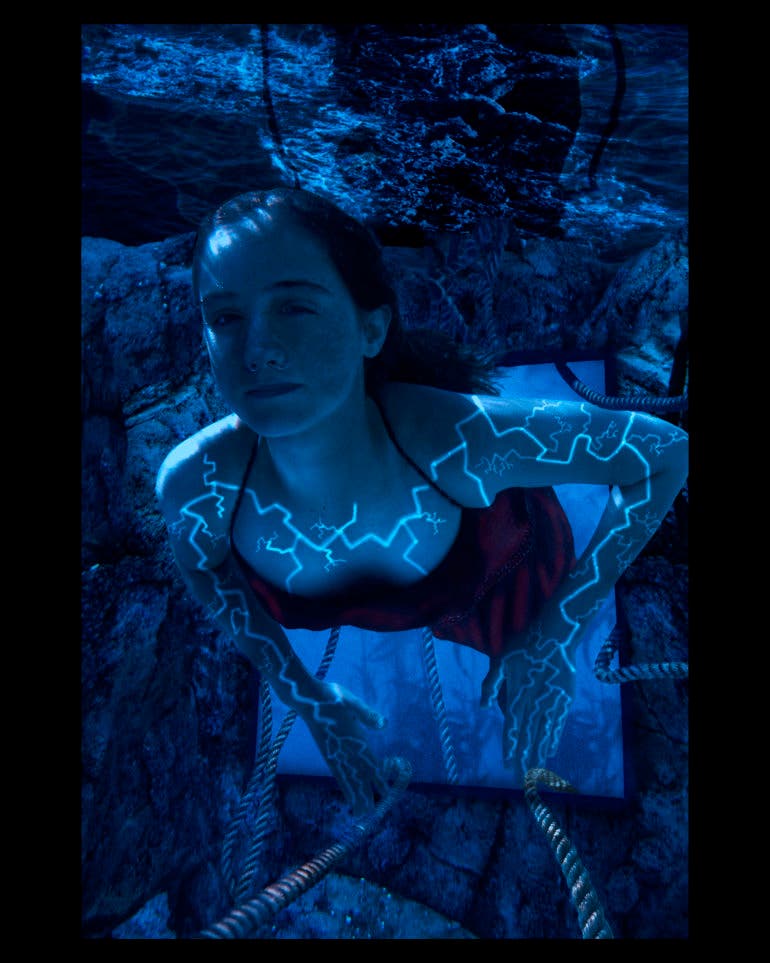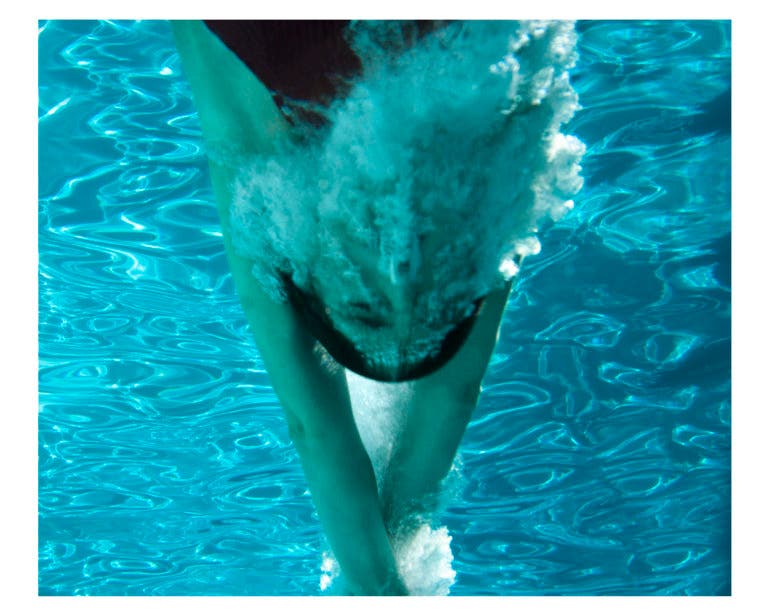For Tom Bendelo, Underwater Photography Is a Wonderful Escape
All images by Tom Bendelo. Used with permission. Images of the model are also used with permission.
My name is Tom Bendelo. I make art to slow down, take a breath, and allow myself to focus on only one thing. I find peace by working and eliminating the noise of the outside world. In my artwork, I try to recreate this same sense of focus and provide my viewer with a moment isolated from reality. I like to shoot out “on-location,” somewhere that is outside of my everyday life. I really love to shoot underwater. It’s a completely different space with a whole new set of challenges for me to overcome. When I first look through the viewfinder, I consider what the final version of my image will look like. I try to preconceive what I will do to the image, how I will edit it.
My main camera is a Nikon D500, and my go-to lens is 18-55mm. Additionally, I use a Nikon D90 for some of my underwater shoots. The 18-55 is such a versatile lens, whether you want to get a nice wide landscape or close in tight around a subject with a shallow depth of field for a portrait. I aspire to invest in a larger underwater housing since the one I currently use is essentially a glorified plastic bag. Along with the housing, it’s my goal to also have a 10-17mm fisheye lens. This will allow me to get closer to a subject to get more detail without losing much of the surrounding area. When I bring a piece into the digital darkroom, I like to experiment; I go through a basic editing process and then add or subtract elements. No matter what I do, though, I never change the primary focus of an image. I try to adapt the rest of the piece to either complement or highlight that subject. With a foundation in analog photography, I approach the digital darkroom manipulating each tool as though it were a physical object in my hand. I do some very basic corrections: I fix exposure, color, contrast, etc., to make my work easier down the line. Once I have a good starting point, I dive deeper into the editing process, figuring out the best way to add rendered elements. When creating a rendered piece, the key is to take your time. If you rush it, then you’ll end up having to redo work. Depending on what I have and the complexity of my idea, a piece can take anywhere from a day to months to complete. When my audience views my work, I hope they find their own sense of peace. Ideally, I can block out the world and allow them to feel the calm I find in my subject. I want them to spend time with each image, asking questions and allowing themselves to experience a moment of tranquility away from the noise of their daily life.
I think that it would be fascinating for the readers to see the work of high school students. For them to see the beginnings of artistic talents and visions. How different students are exploring new topics, such as underwater photography, and how these students are sharing their message.

Why did you get into photography?
Tom Bendelo: My interest in media began as an interest in videography when I was younger, but I soon learned that I was able to create more complex scenes and images from scratch through photography. Photography also allows me to capture a single moment by creating emotions, movement, and the ability to draw the viewer’s eye to one specific subject or part of the image, all from my own head.
Which photographers are your biggest influences? How did they affect who you are and how you create?
Tom Bendelo: My teacher, Rebecca A. Kandel-Scott, has had a huge impact on who I am as a photographer. She has taught me a lot of the skills I know and helped create my own style of photography. Additionally, one photographer who influenced part of my style is Peter McKinnon. I took a lot of inspiration from both his style of work and his process. Another photographer who I have recently started following the work of Jason Washington, an underwater photographer based in the Cayman Islands. I have yet to really explore underwater photography, but I have definitely gotten a lot of ideas from his work and his process in terms of lighting and editing work.
How long have you been shooting? How do you feel you’ve evolved since you started?

Tom Bendelo: I am a junior in high school and therefore have only been shooting for about four years. However, in these four years, I have devoted all my time to my art. When I first began, I was very uninterested in portraiture, but it has become my main genre of photography since then. I have also recently started to gain an interest in photo composites and underwater photography. Overall, I feel that I have developed technically, but I have also evolved in story-telling through my images and through surreal work.
Tell us about your photographic identity.
Tom Bendelo: I am a very hardworking individual; in my art, I am very receptive to feedback on all of my work and willing to make revisions to a piece over and over. I’m not willing to let it go or call it “done” until I feel that it fully conveys the message I want to communicate, and I have examined it to the tiniest detail, and there are no missing pieces. Also, I’m a very systematic person; I often have a pre-conceptualized idea for my image before I even pick up the camera. With this idea in mind, I try to work out the best way to reach my end goal: what steps to take and in what order. I also tend to be very empathetic; I am able to read the people I know and read the mood of a room. This comes through in my portraiture as I try to connect the viewer with the model. I want to share the model’s perspective and story with the viewer all through one captured moment.
Essential Gear
· Nikon D500
· Nikon D90
· Nikon 18-55mm Lens
· Nikor 70-210mm Lens
· Nikor 55mm Lens
· Nikor 28mm Lens

Natural light or artificial light? Why?
Tom Bendelo: I prefer natural light because it adds so much color to the scene. It is also a fun challenge to use natural light to your advantage, natural silhouettes, warm tones, etc.
Why is photography and shooting so important to you?
For me, photography isn’t just a hobby, but it’s a means of escape. It’s something that helps me to forget everything and focus on one thing. The reason I enjoy underwater photography is that being underwater is like being on a different planet. As you dive beneath the surface, every single worry weighing you down on dry land floats away. I want to share this feeling with my viewer and also offer them an escape. Photographers are very important because we capture things that most people don’t see. We offer a unique way of looking at the world around us and conveying messaging that influences others and often change their opinions.
Do you feel that you’re more of a creator or a documenter? Why? How does the gear help you do this?
Tom Bendelo: I am more of a creator because rather than capturing a pre-existing story, I try to create and tell my own. Beyond simple in-camera work, I really manipulate the image to create the scene I want in the editing software, which allows me to tell a deeper, more personal story. The gear I use allows me to shoot in uncompressed RAW, which means that I have the most data and room to play within the editing software. The 18-55 f3.5 is also very versatile and allows me to capture pretty much any shot I want at any depth of field.
What’s typically going through your mind when you create images?
Tom Bendelo: The first thing I do is pre-conceptualize what the final image will look like. Then I ask myself whether I’m going to manipulate the image in the editing software, changing the background scene, lighting, etc. From there, I know how to best capture the image. When working with a model, it’s very important to give instruction down to the smallest detail, the shape of their mouth, how wide you want their eyes open, etc. I am fortunate to have a model who I am very close to and who is willing to work with me as I try new things. Not only is she great at following these directions, but she also collaborates with me and will often come up with an even better idea that helps guide the process.

Please walk us through your processing techniques?
Tom Bendelo: During the shoot, I always picture what the final image is going to look like. That way, I know how to best capture the image. This includes choosing which part of the image to expose for, depth of field, and framing. After the shoot, I bring the images into the editing software, where I do some very basic corrections: I fix exposure, color, contrast, etc., to make my work easier down the line. Once I have a good starting point, I dive deeper into the editing process, figuring out the best way to add elements. When creating a photo composite piece, the key is to take your time. If you rush it, then you’ll end up having to redo work. Depending on what I have and the complexity of my idea, a piece can take anywhere from a day to months to complete.
Tell us about the project or portfolio that you’re pitching to us.



Tom Bendelo: This series of photographs are all part of an exploration into underwater photography. My initial goal was to explore how light travels through water and how to take advantage of the concept of “weightlessness.” When I started this project, I did mainly want to play around with being underwater, how the light is different, etc. But there was always a deeper story I was trying to tell. This story is about our oceans and advocating for their importance. We rely on our oceans for survival, and yet we are rapidly killing them. The series includes both portraits and photo composites. The three pieces (Trapped, Suspense, and Release) tell the story of a creature who harnesses a form of power that scientists want to capture. Across these three pieces, we see her journey from the moment that they capture her in Suspense to when she is finally free from their torture in Release. We see the struggle she endures and the destructive nature of the humans experimenting on her. I have used the same model throughout this entire series, which is beneficial because as I learn more and become more adept in this style of photography, she has matured alongside me and is able to help me get the image I want. All these shots have been taken in the controlled environment of a pool.
However, this was not as simple as it sounds. First, I don’t have a pool, and so I have had to seek water. Initially, my former math teacher was generous enough to allow me to use her pool. I recently used a pool at a vacation house that I went to over this past summer. Some of these images are presented as they were taken, with minimal adjustments. Others are more elaborate with props, clothing, and extensive editing. This is an ongoing project, and I feel that I have only scraped the surface of what is possible with this type of work. I am saving to invest in larger underwater housing. Once I have that equipment, I want to make my work in the ocean itself and capture the underwater world.
I want to show people how important it is to protect our oceans for our survival and just the peacefulness and beauty beneath the surface. I still remember my very first scuba dive, feeling like a part of something bigger than what is on land, seeing what could have very well been from another world. Looking up and seeing the surface from below, I couldn’t stop smiling from the moment my head went beneath the waves to when I got back on the boat. I want to share that happiness and those feelings with other people, and I think that art is a perfect way to accomplish that.
What made you want to get into your genre?
Tom Bendelo: Even when I was working in motion pictures, I always wanted to create much more manipulated scenes. I wanted to add elements such as smoke and artificial lighting. I also wanted to change out the background. As a member of the technical theatre crew on my campus, I exercise this same process of pre-conception. From day one of production, you have to think about the final product; what the set will look like, what will the lighting design be, what sound effects should be used, etc. All these skills have informed my photographic process.

What motivates you to shoot?
Tom Bendelo: The biggest motivation for me is knowing that while I’m shooting and editing, it is a time for me to just focus on my art and truly connect with the piece. I can forget about everything that is troubling me. Making art is also a great way to tell my story and is a way for me to release stress. I’ll often see something as I’m driving around, and an image will just pop into my head of how I could use whatever I just saw in a piece. I am motivated to share my message for protecting our oceans and exposing more people to the beauty beneath the surface.

For more from Tom, check out his website. Tom’s interview was published with consent from his parents. The images of the model are published with the consent of Rebecca A. Kandel-Scott.